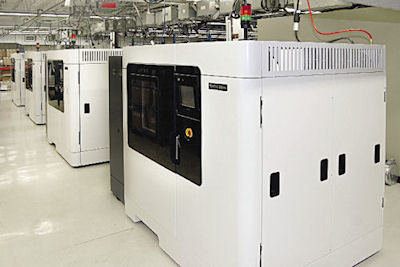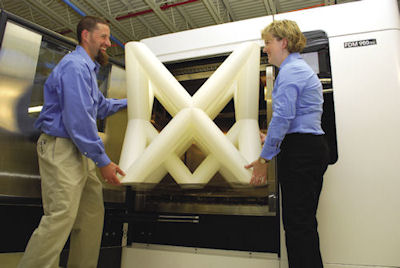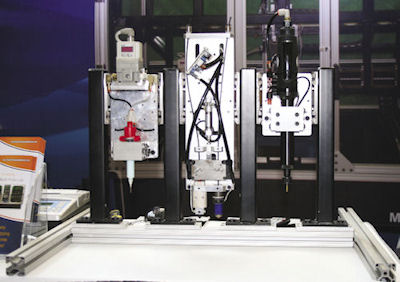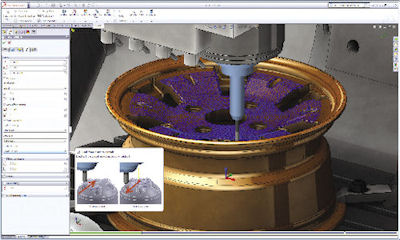Rapid Prototyping Tech Converges
Additive and subtractive technologies begin to merge in latest rapid prototyping processes and equipment.
Latest News
October 1, 2013
Recently, the Picatinny, NJ-based U.S. Army Armament Research, Development and Engineering Center (ARDEC) approached the National Nanotechnology Manufacturing Center (NNMC) in Swainsboro, GA, looking for a solution that would do two types of prototyping for one of their projects while maintaining accuracy between the processes of each. It’s an example of the demands of prototyping for design, where flexibility and accuracy are key. The emergent capabilities of 3D printing are beginning to combine with traditional subtractive prototyping to meet such demands.
 RedEye operates more than 150 AM systems globally, including nearly 100 from its Minneapolis headquarters. Image courtesy of RedEye.
RedEye operates more than 150 AM systems globally, including nearly 100 from its Minneapolis headquarters. Image courtesy of RedEye.The result was the development of NNMC’s patent-pending Multi Prototyping Lab (MPL).“They (ARDEC] wanted to do milling and then precisely lay down a paste on the machined part. Every time that the part was moved from the milling machine to the machine that laid down the paste, too much accuracy was lost,” explains Calvin Close, NNMC’s marketing manager. “ARDEC asked us to find a solution.”
 Large FDM machines (such as Stratasys’ Fortus 900mc) allow companies to produce parts as large as 36x24x36 in. with real production-grade thermoplastics, making them durable enough for end-use. Image courtesy of RedEye.
Large FDM machines (such as Stratasys’ Fortus 900mc) allow companies to produce parts as large as 36x24x36 in. with real production-grade thermoplastics, making them durable enough for end-use. Image courtesy of RedEye.The Rapid Prototyping Evolution
“The concept of the MPL was that the prototype part is locked in position, then different prototyping processes are brought to the part, all within one machine.” Close explains. “The MPL is a multimodule machine. Each module, or attachment, performs a unique process such as 3D printing, drop-on-demand printing or laser curing. The MPL picks up a module such as the 3D Dual Additive Printing Module from its parked position, and performs that process on the prototype part. Once that process is completed, it returns the module to its parked position. The MPL then picks up another module, such as Drop-On- Demand Printing Module, and performs that process on the same prototype piece.”
The speed and flexibility of 3D printing enables part consolidation, experimentation with different materials, creation of limited-edition as well as jig production—and the ability to do this right in the convenience of an office setting.
“3D printing can be utilized to tackle the most unique design challenges in a host of industries,” observes Bill Camuel, project engineering manager at RedEye, by Stratasys, headquartered in Minneapolis. “Our engineers frequently help companies minimize assembly by consolidating dozens of parts into one, and making once-fragile parts more structurally stable.
 NNMC’s Multi Prototyping Lab combines additive and subtractive technologies in one machine.
NNMC’s Multi Prototyping Lab combines additive and subtractive technologies in one machine.Computer-aided manufacturing is a mature technology, but it too continues to evolve to meet today’s latest machining or subtractive technologies and strategies, explains Anthony Graves, product manager for the CAM, DLS Group at Autodesk.Camuel notes that 3D printing can also be a bridge to traditional manufacturing, helping production parts get to customers faster and cheaper.
“In the future, you will begin to see a whole new set of users begin to discover and leverage the benefits of subtractive manufacturing—starting in prototyping departments and small companies whose users you wouldn’t normally associate with the title ‘machinist,’ or someone who typically runs a CNC machine,” he says. “To support this reality, Autodesk has been working to deliver technologies that are truly open or classified as ‘Open CAD.’ For instance, we are developing CAM solutions for users of SolidWorks and Inventor. The objective is a completely integrated, seamless workflow.”
As 3D printing and computer numerically controlled (CNC) machining technologies evolve, Grave notes, “there is a growing trend for designers and engineers to take a larger role in the creation of prototypes and production of their designs. From small businesses that normally outsource such work, to crowd-sourced start-ups, to even professional model shops and prototyping departments, CAM is the tool that allows designers and engineers to access the world of machining and subtractive manufacturing. The familiar user interface and workflow provides users with a comfortable environment where they can learn take advantage of what both additive and subtractive technologies have to offer.”
 A screenshot of Autodesk’s HSMWorks for SolidWorks software. Image courtesy of Autodesk and GTVC, Inc.
A screenshot of Autodesk’s HSMWorks for SolidWorks software. Image courtesy of Autodesk and GTVC, Inc.While both additive and subtractive technologies are being used by more and more design engineers at different steps along the product design process, NNMC’s Close says putting both processes together in one machine has added benefits.
Additive and Subtractive All-in-One
“You can print an ABS plastic part, and machine the surface extremely precisely—and then print a copper track directly on the machined surface.”
He says another great capability of the MPL is part production in remote locations. “You can have one machine in your office, and another machine in a war zone, the Antarctic or even on the moon,” he says. “Design and produce the part in your office. When you are satisfied with the part, send the code to the remote machine and you can produce the part remotely. Now, instead of having to send parts to the moon, you can have some base materials there and produce whatever parts you need on demand. With our 3D Camera or Laser Inspection module, you can precisely check the remote part for correct dimensions, as well as visually inspect the part.”
The MPL also has the capability to produce fully functional parts in one machine. “You can produce half of an ABS plastic part, print copper tracks directly on the part, add discrete components using the Pick and Place Module, solder the components to the copper track, then print the remaining ABS plastic to complete the part,” Close explains. “You have just produced a complete part with embedded, encapsulated electronics. This cannot be done with any other existing technology in a single machine.”
While that is true, there are a few newcomers looking to follow the path that NNMC has cleared over the five years and more than $1 million it has spent developing the MPL.
Mebotics, LLC, for instance, has launched a Kickstarter campaign to support its Microfactory, which it calls “the first widely-available machine to marry both additive and subtractive manufacturing, integrating machining and 3D printing into a safe, self-cleaning, networkable unit.”
The company says that, along with 3D printing parts in plastic, the system can machine parts with wood or metals. It’s even intended to be accurate enough to allow users to etch their own microchips.
At presstime, only $36,860 of the Microfactory’s $1 million fundraising goal had been met, with 14 days left in the fundraising campaign.
That may have something to do with a competing Kickstarter campaign for AIO Robotics’ Zeus, which claims to be “the first and only device that allows users to 3D scan, print, copy, and fax objects with a touch of a button from one device.” It surpassed its $100,000 fundraising goal in 24 hours. While Zeus doesn’t include subtractive technologies, it does integrate 3D scanning.
Another device that recently made the crowdfunding rounds promises 3D scanning, 3D printing and milling of different materials like foams, woods, aluminium or brass. At presstime, FABtotum’s Personal Fabricator had more than tripled its $50,000 goal, and still had 25 days to go in the fundraising campaign on Indiegogo.
The additive side of the Personal Fabricator has an 8.2 x 9.4 x 9.4 in. build envelope, and an extruder head designed to be interchangeable with third-party heads. For subtractive prototyping, FABtotum claims PCB milling, engraving, and CNC pre-drilling.
As more rapid prototyping innovations continue to emerge and traditional technologies continue to advance, design engineers stand to gain the most from integrating rapid prototyping—whether from service providers, 3D printers, CNC machines or a combination—into their design cycles.
Jim Romeo is a freelance writer based in Chesapeake, VA. Send e-mail about this article to [email protected].
More Info
Subscribe to our FREE magazine, FREE email newsletters or both!
Latest News
About the Author
Jim Romeo is a freelance writer based in Chesapeake, VA. Send e-mail about this article to [email protected].
Follow DE





